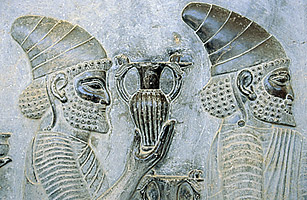
© CorbisAn ancient Persian stone relief in Persepolis, Iran
In 525 B.C., the Persian Emperor Cambyses dispatched 50,000 of his soldiers to lay waste to an oasis temple in the Sahara because its oracle had spoken ill of his plans for world domination.
The punitive expedition proved to be one of antiquity's most dramatic episodes of imperial overreach. One morning, while the army was having breakfast, writes the ancient historian Herodotus in
The Histories, it was set upon by "a violent southern wind, bringing with it piles of sand, which buried them." The Greek continues, "Thus it was that they utterly disappeared."
For centuries, this little anecdote - like many others in Herodotus's famous text - seemed to be a myth. The Histories is lined with rumors and fantastical hearsay of ants that dig for gold, rings that make their bearers invisible and winged serpents that patrol remote mountain passes.
But recent excavations in western Egypt by a team of Italian archaeologists may have unearthed traces of this long-lost army, entombed in the desert for some 2,500 years.
The team, led by a veteran pair of twin brothers, Alfredo and Angelo Castiglioni, put forward what they claim is the first physical evidence of the army's remains. More than a decade of digs and explorations have turned up earthenware pots, fragments of weaponry dating to the 6th century B.C. and hundreds of human bones. A earring seen as similar to equivalent ancient Achaemenid, or Persian, jewelry has also been recovered. "We are talking of small items," said Alfredo Castiglioni to reporters this week. "But they are extremely important as they are the first Achaemenid objects ... dating to Cambyses' time, which have emerged from the desert sands."
Over the years the twins have shown a knack for finding ancient glories thought lost. In 1989, they uncovered the ruins of the legendary Egyptian city of Berenike Panchrysos, a desert town once allegedly paved with gold. The first breakthrough in the hunt for Cambyses' army came in 1996, when the Castiglioni brothers ran across a cache of Persian arrow tips and dagger blades beneath a rock outcrop not far from the oasis of Siwa - near the modern-day Egyptian border with Libya and the site of the sacred Amon temple, whose oracle was worshipped by Greeks and Egyptians alike. Cambyses' army had set out from the city of Thebes to reach Siwa and plunder its temple, but never made it.
Many adventurers, particularly in the 19th century, sought to find proof of their passing, plying the traditional caravan routes through the desert in the hope that the Persians had succumbed to the sandstorm and perished somewhere along the way. In the 1930s, the most famous man who searched for the army was László Almásy, a Hungarian aristocrat who, in his wanderings, claimed to find the mythical oasis of Zerzura - "the oasis of little birds" - and became the subject of Michael Ondaatje's best-selling novel,
The English Patient.
The Castiglionis reckoned that Cambyses' army must have taken a different route from Thebes into the desert than the one explored by earlier generations of archaeologists. Geological surveys they conducted over a new stretch of terrain further afield from the old caravan track revealed dried-up wells and pieces of earthenware pottery from Persian water pots. The army may have taken this alternative path through the desert in order to surprise the defenders of the Amon temple, but were stopped short by the unforgiving Saharan khamsin wind, which triggered sandstorms that scattered and eventually destroyed the attacking troops. The Castiglionis' team also heard bedouin tales of an entire valley of bleached human skulls and bones and they did indeed come across a grave of skeletons not far from Siwa. Among the bones was a bit used by Persian cavalrymen to tether their steeds.
The Italian team now believe the rest of the army lies not far from the bulk of their discoveries, some 100 km south of Siwa. They have communicated their findings to the Egyptian government and its archaeological authorities, though the government has yet to make an official statement. Egypt's Supreme Council for Antiquities is notoriously territorial about excavations and, on occasion, prickly when having to hail the successes of foreign archaeologists.
However the project goes forward, the findings bring to life a cautionary tale that has not always been remembered by subsequent generations. Like Napoleon's march into Russia, Cambyses' doomed campaign serves as perhaps the ultimate act of hubris, of a power-hungry monarch who refuses to accept the limits to his ambitions. While these 50,000 Persian warriors disappeared in the desert, Cambyses didn't fare much better. At the time, he was marching on a kingdom in Ethiopia, but provisions ran out beneath a scorching sun and his troops were forced to pick lots having divided into groups of 10. According to Herodotus, the unfortunate 1 of each 10 was killed and eaten by the other ravenous troops. Cambyses eventually withdrew, chastened by Egypt and its desert.
Reader Comments
to our Newsletter